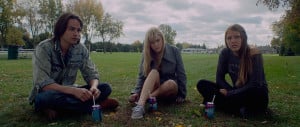
One of the most unexpectedly frightening phenomena is the sight of someone walking, slowly towards you. It is this fear that writer-director David Robert Mitchell harnesses in his latest feature “It Follows,” which focuses on a teenage protagonist, Jay, hunted by a supernatural killer that begins stalking her after she has sex with her duplicitous boyfriend. “It” possesses supernatural strength. “It” can take any human form. “It” cannot be stopped, though “It” isn’t very fast. “It” only walks. A monster that is ceaseless, but slow. The entire film is an exercise in sustained dread, as we wait, scanning the screen for a figure we know is inevitably coming. It is quite terrifying and incredibly entertaining.
“It Follows” is a throwback to the age of the slasher film, a genre which first gained prominence in the late ‘70s. The slasher flicks were those blood-soaked films where some unstoppable killer stalked a bunch of horny teenagers, killing them off one by one until a lone (usually virginal) female remained. Of course, the ‘70s were a long time ago, and “It Follows” has the benefit of being able to build upon an already sturdy foundation. For one, the film updates the puritanical sexual politics of many older slasher films. In “It Follows,” the only way to truly survive is to pass “It” along to someone else through sex.
Another welcome update: The characters in this film are significantly more likeable than your average killer fodder. While many films in the genre focus on a set of completely terrible human beings for 90 minutes before gratifyingly murdering them all, most of the characters in this film are relatively nice people. In fact, there is something “Buffy”-esque about how these people band around Jay to protect her from a supernatural entity, while still finding the time to behave like teenagers.

That being said this movie is short, like many great suspense films, and thus we only have a limited amount of time to spend learning about each character. But Mitchell makes the most of this time, finding innovative and succinct ways to create convincing, interesting teenage characters. There is a moment midway through the film when the characters discuss a major plot machination while sitting outside on the grass in a circle. A director more divorced from his childhood would have shot this scene inside or around a table. But that would have made the characters appear like adults, like they owned and controlled the table or the house. Mitchell, more than many other directors, understands the lack of control that comes with being a teenager.

Of course, it comes as no surprise that the director of the poignant coming-of-age story “Myth of the American Sleepover” understands how to shoot teenage characters. What is more surprising is how adept Mitchell is at crafting horror sequences. Filming in beautiful, carefully composed widescreen — many of the shots in this film are stunningly symmetric — Mitchell uses deep focus and cluttered compositions to create an immensely frightening experience.There is always motion in the background — sometimes it’s something as harmless a branch swaying in the wind, sometimes it’s something far less innocuous. Early in the film, Jay spots a middle-schooler peeping at her from behind a bush, and from this moment forward the film continuously reminds the audience of the importance of observing seemingly distant space. Whether or not Jay notices the odd figure outside her window walking slowly towards her, we certainly do.
This is an immensely enjoyable, subtle, and well-thought horror film — one that understands how to use film form to create fear. In a better world, this movie would serve as a corrective to every filmmaker that wants to make a horror film that relies solely on content, blood and gore. Most horror films end bombastically, with a corpse emerging from a grave or the killer claiming one final victim, all set to the shrieks of a pulsing score. This film ends quietly. The only sound we hear during the film’s final moments is the gentle noise of someone watering his lawn on a quiet suburban street. Yet it is, quite possibly, the most terrifying thing I have witnessed this year.
Contact Raymond Maspons at raymondm ‘at’ stanford.edu.
